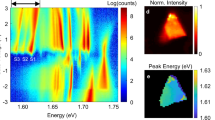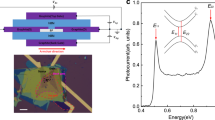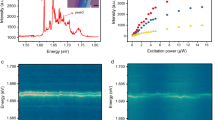Abstract
Semi-metallic graphene and semiconducting monolayer transition-metal dichalcogenides are the most intensively studied two-dimensional materials of recent years1,2. Lately, black phosphorus has emerged as a promising new two-dimensional material due to its widely tunable and direct bandgap, high carrier mobility and remarkable in-plane anisotropic electrical, optical and phonon properties3,4,5,6,7,8,9. However, current progress is primarily limited to its thin-film form. Here, we reveal highly anisotropic and strongly bound excitons in monolayer black phosphorus using polarization-resolved photoluminescence measurements at room temperature. We show that, regardless of the excitation laser polarization, the emitted light from the monolayer is linearly polarized along the light effective mass direction and centres around 1.3 eV, a clear signature of emission from highly anisotropic bright excitons. Moreover, photoluminescence excitation spectroscopy suggests a quasiparticle bandgap of 2.2 eV, from which we estimate an exciton binding energy of ∼0.9 eV, consistent with theoretical results based on first principles. The experimental observation of highly anisotropic, bright excitons with large binding energy not only opens avenues for the future explorations of many-electron physics in this unusual two-dimensional material, but also suggests its promising future in optoelectronic devices.
This is a preview of subscription content, access via your institution
Access options
Subscribe to this journal
Receive 12 print issues and online access
$259.00 per year
only $21.58 per issue
Buy this article
- Purchase on Springer Link
- Instant access to full article PDF
Prices may be subject to local taxes which are calculated during checkout



Similar content being viewed by others
References
Geim, A. K. & Novoselov, K. S. The rise of graphene. Nature Mater. 6, 183–191 (2007).
Wang, Q. H., Kalantar-Zadeh, K., Kis, A., Coleman, J. N. & Strano, M. S. Electronics and optoelectronics of two-dimensional transition metal dichalcogenides. Nature Nanotech. 7, 699–712 (2012).
Li, L. et al. Black phosphorus field-effect transistors. Nature Nanotech. 9, 372–377 (2014).
Xia, F., Wang, H. & Jia, Y. Rediscovering black phosphorus as an anisotropic layered material for optoelectronics and electronics. Nature Commun. 5, 4458 (2014).
Liu, H. et al. Phosphorene: an unexplored 2D semiconductor with a high hole mobility. ACS Nano 8, 4033–4041 (2014).
Koenig, S. P., Doganov, R. A., Schmidt, H., Castro Neto, A. H. & Özyilmaz, B. Electric field effect in ultrathin black phosphorus. Appl. Phys. Lett. 104, 103106 (2014).
Rodin, A. S., Carvalho, A. & Castro Neto, A. H. Strain-induced gap modification in black phosphorus. Phys. Rev. Lett. 112, 176801 (2014).
Tran, V., Soklaski, R., Liang, Y. & Yang, L. Layer-controlled band gap and anisotropic excitons in few-layer black phosphorus. Phys. Rev. B 89, 235319 (2014).
Qiao, J., Kong, X., Hu, Z.-X., Yang, F. & Ji, W. High-mobility transport anisotropy and linear dichroism in few-layer black phosphorus. Nature Commun. 5, 4475 (2014).
Ling, X., Wang, H., Huang, S., Xia, F. & Dresselhaus, M. S. The renaissance of black phosphorus. Proc. Natl Acad. Sci. USA http://dx.doi.org/10.1073/pnas.1416581112 (2015).
Morita, A. Semiconducting black phosphorus. Appl. Phys. A 39, 227–242 (1986).
Scholes, G. D. & Rumbles, G. Excitons in nanoscale systems. Nature Mater. 5, 683–696 (2006).
Zhang, S. et al. Extraordinary photoluminescence and strong temperature/angle-dependent Raman responses in few-layer phosphorene. ACS Nano 8, 9590–9596 (2014).
Sugai, S. & Shirotani, I. Raman and infrared reflection spectroscopy in black phosphorus. Solid State Commun. 53, 753–755 (1985).
Fei, R. & Yang, L. Lattice vibrational modes and Raman scattering spectra of strained phosphorene. Appl. Phys. Lett. 105, 083120 (2014).
Li, P. & Appelbaum, I. Electrons and holes in phosphorene. Phys. Rev. B 90, 115439 (2014).
Mak, K. F., Lee, C., Hone, J., Shan, J. & Heinz, T. F. Atomically thin MoS2: a new direct-gap semiconductor. Phys. Rev. Lett. 105, 136805 (2010).
Splendiani, A. et al. Emerging photoluminescence in monolayer MoS2 . Nano Lett. 10, 1271–1275 (2010).
Eda, G. et al. Photoluminescence from chemically exfoliated MoS2 . Nano Lett. 11, 5111–5116 (2011).
Zeng, H., Dai, J., Yao, W., Xiao, D. & Cui, X. Valley polarization in MoS2 monolayers by optical pumping. Nature Nanotech. 7, 490–493 (2012).
Mak, K. F. et al. Tightly bound trions in monolayer MoS2 . Nature Mater. 12, 207–211 (2013).
Ugeda, M. M. et al. Giant bandgap renormalization and excitonic effects in a monolayer transition metal dichalcogenide semiconductor. Nature Mater. 13, 1091–1095 (2014).
Wang, F., Dukovic, G., Brus, L. E. & Heinz, T. F. The optical resonances in carbon nanotubes arise from excitons. Science 308, 838–841 (2005).
Spataru, C. D., Ismail-Beigi, S., Capaz, R. B. & Louie, S. G. Theory and ab initio calculation of radiative lifetime of excitons in semiconducting carbon nanotubes. Phys. Rev. Lett. 95, 247402 (2005).
Tran, V. & Yang, L. Scaling laws for the bandgap and optical response of phosphorene nanoribbons. Phys. Rev. B 89, 245407 (2014).
Çakır, D., Sahin, H. & Peeters, F. M. Tuning of the electronic and optical properties of single-layer black phosphorus by strain. Phys. Rev. B 90, 205421 (2014).
Lin, Y. et al. Dielectric screening of excitons and trions in single-layer MoS2 . Nano Lett. 14, 5569–5576 (2014).
Blake, P. et al. Making graphene visible. Appl. Phys. Lett. 91, 063124 (2007).
Cheiwchanchamnangij, T. & Lambrecht, W. R. Quasiparticle band structure calculation of monolayer, bilayer, and bulk MoS2 . Phys. Rev. B 85, 205302 (2012).
Chernikov, A. et al. Non-hydrogenic exciton Rydberg series in monolayer WS2 . Phys. Rev. Lett. 113, 076802 (2014).
Tongay, S. et al. Defects activated photoluminescence in two-dimensional semiconductors. Sci. Rep. 3, 2657 (2013).
Bao, Q. et al. Broadband graphene polarizer. Nature Photon. 5, 411–415 (2011).
Xia, F., Sekaric, L. & Vlasov, Y. Ultracompact optical buffers on a silicon chip. Nature Photon. 1, 65–71 (2007).
Acknowledgements
This work was mainly supported by the Office of Naval Research (N00014-14-1-0565). M.J., K.S. and X.X. are supported by the Department of Energy, Basic Energy Sciences, Materials Sciences and Engineering Division (DE-SC0008145 and DE-SC0012509). H.Z. and H.W. are supported by Army Research Laboratory (W911NF-14-2-0113). The use of facilities in Yale was supported by Yale Institute for Nanoscience and Quantum Engineering (YINQE) and the National Science Foundation (MRSEC DMR-1119826). The UW facility is partially supported by the State of Washington through the University of Washington Clean Energy Institute. V.T. and L.Y. are supported by the National Science Foundation (DMR-1207141). The authors acknowledge Mildred Dresselhaus at Massachusetts Institute of Technology for helpful comments during the preparation of the manuscript.
Author information
Authors and Affiliations
Contributions
F.X., X.W. and H.W. conceived the projects. X.W. prepared samples and carried out Raman measurements. A.M.J., K.L.S. and X.W. performed photoluminescence measurements. V.T. and L.Y. performed the density functional theory calculations. Y.J. and H.Z. helped with sample preparation. F.X. and X.W. wrote the manuscript with input from L.Y., X.X. and H.W. F.X. and X.X. supervised the project. All authors discussed the results and commented on the manuscript.
Corresponding authors
Ethics declarations
Competing interests
The authors declare no competing financial interests.
Supplementary information
Supplementary information
Supplementary information (PDF 715 kb)
Rights and permissions
About this article
Cite this article
Wang, X., Jones, A., Seyler, K. et al. Highly anisotropic and robust excitons in monolayer black phosphorus. Nature Nanotech 10, 517–521 (2015). https://doi.org/10.1038/nnano.2015.71
Received:
Accepted:
Published:
Issue Date:
DOI: https://doi.org/10.1038/nnano.2015.71
This article is cited by
-
Prediction of BiS2-type pnictogen dichalcogenide monolayers for optoelectronics
npj 2D Materials and Applications (2024)
-
Manipulating hyperbolic transient plasmons in a layered semiconductor
Nature Communications (2024)
-
Black Phosphorus–Based Metamaterial Double-Band Anisotropic Absorber for Sensing Application in Terahertz Frequency
Plasmonics (2024)
-
A brief review of tribological properties for black phosphorus
Friction (2024)
-
Biomedical application of 2D nanomaterials in neuroscience
Journal of Nanobiotechnology (2023)



